Get a real life review of a Restoration Hardware dining table! We’ll also show you how to protect your Restoration Hardware dining table, coffee table or desk.
Learn about all the options and what we ultimately went with and love seven + years later!
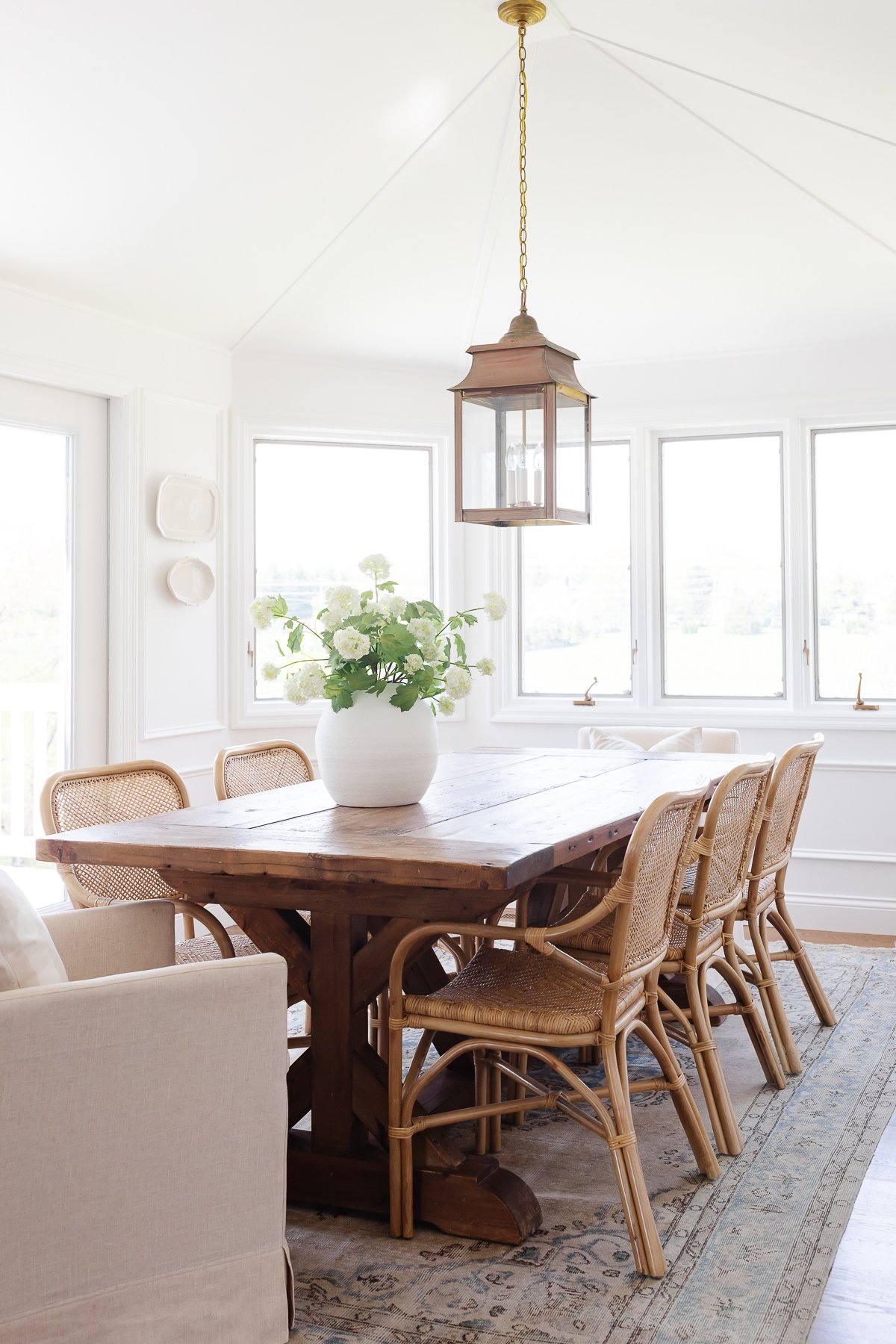
I haven’t written about our Restoration Hardware table since shortly after we received it because I allowed it to paralyze me. Things didn’t go as planned, to say the least, and this table caused us a lot of frustration.
The stress, disappointment and overwhelm was just too much. Instead, our family of five sat at an antique table, intended to be my kitchen desk.
It was tight. Our legs didn’t even fit underneath it. We just “closed off” the sunroom and pretended that it, along with the table, simply didn’t exist.
When we purchased a Restoration Hardware dining table with a natural finish, we envisioned it weathering over time. We wanted a rustic farmhouse table that would only become prettier over time – if you found your way here, you might have wanted the same thing.
Restoration Hardware Dining Table
The reality was different, however. The first time we wiped the table down after dinner with a damp cloth, we removed the finish. You can imagine the horror!
We quickly realized the “natural” finish is a beautiful powder that is simply not practical for day to day living. That soft, dusty look is unachievable in a maintainable form.
Underneath the powder the reclaimed wood table merely looked like wood purchased from your local hardware store.
We poured over the options time and time again, and realized that the perfect Restoration Hardware table just doesn’t exist. Fortunately, there are several options to protect your Restoration Hardware dining table. However, whatever product you use, will alter the finish.
We have purchased several pieces of Restoration Hardware’s natural finish including a dresser, chest of drawers and two dining room tables. We’ve had a lot of experience using the furniture over the last decade and most importantly, protecting it.
We made a lot of mistakes on our first Restoration Hardware dining table, but fortunately, you don’t have to! Today I’m sharing both how to protect and repair.

Read about How to Clean Linen Furniture from Restoration Hardware (or anywhere)!
RH Natural Finish
Restoration Hardware’s website notes on the description for the reclaimed wood table care recommendations.
“For dining tables, use of tablecloths, placemats and coasters is recommended to prevent staining. Clear furniture wax can be applied to protect the finish from minor spills. Use coasters or placemats to help prevent marks or stains.” and to “Wipe the table clean with a soft, dry cloth after each use.”
Their site also says “Care: Wipe using a damp cloth with mild soap and water, followed by a dry cloth. Wipe spills up immediately with a dry cloth.” However, that conflicts with their detailed care instructions. I (along with many of you) found that a damp cloth takes the finish right off.
After our first failure, we purchased a new RH dining table. We wanted to start fresh and fortunately were able to re-coop most of the expense we had invested in our previous farmhouse table.
We purchased this table with intention. This time we knew the powder finish would wipe off, so we took steps to protect it prior to use. Here is what we learned.
Products for Protection
- Wax
- Modern Masters Dead Flat
- Pure Tung Oil
- Polyurethane
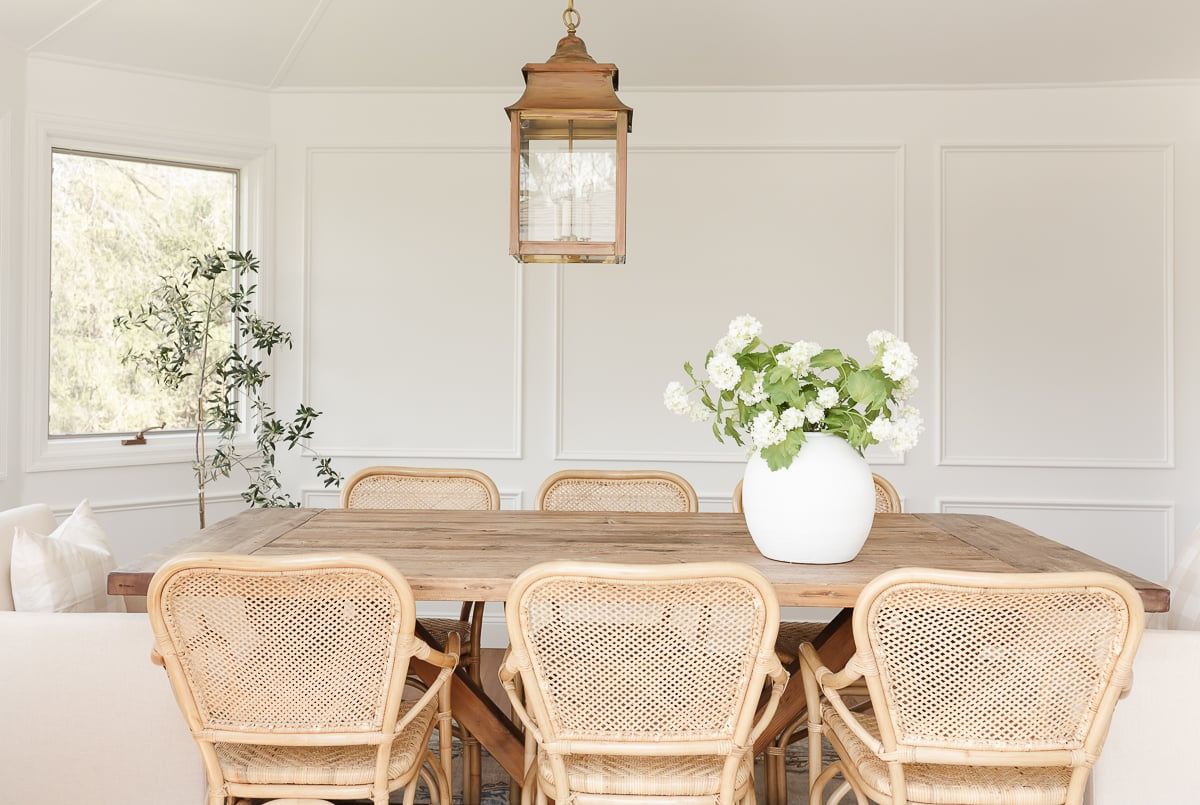
The Pros and Cons of Each Option
Wax
Pros:
- Recommended by Restoration Hardware
- Very little alteration to the table
- Minimal sheen
- Easy to apply
Cons:
- Minimal protection
- Minimally water resistant
- Removes with solvent
- Requires reapplication
- Heat leaves rings
Best Use: Limited wear pieces like the Restoration Hardware Coffee Table, Side Table or Dressers
Modern Masters Dead Flat
Pros:
- Minimal sheen
- Very little alteration to the table
- Easy to apply
Cons:
- Minimal protection (markers, etc don’t wipe off)
- Minimally water resistant
Best Use: Limited wear pieces like the Restoration Hardware Coffee Table, Side Table or Dressers
You can purchase Modern Masters Dead Flat Varnish here.
A reader, Paula, graciously sent a photo of her table sealed with this finish. We used it on our kitchen island you can learn more about it here and the protection it provides.
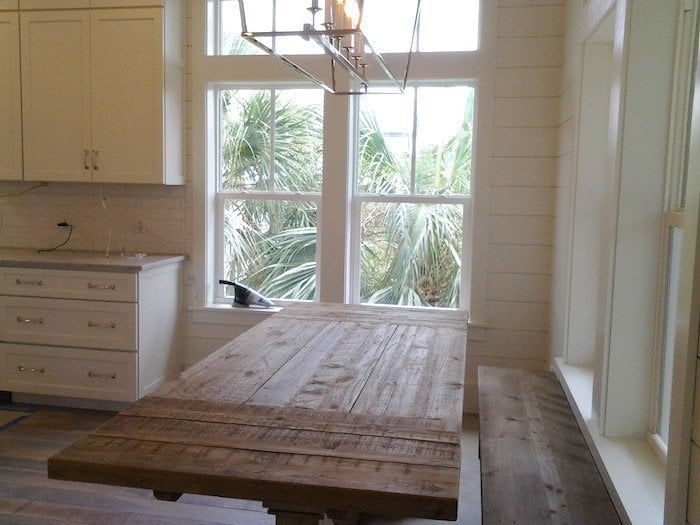
Polyurethane
Pros:
- Easy to apply
Cons:
- Even the matte finish has a sheen
- Not waterproof
- Doesn’t stand up to abrasion
Pure Tung Oil
This is the option we chose. See below for more details and a step by step tutorial.
Pros:
- Waterproof
- Marker, glue, etc wipe clean
- No need to reapply
Cons:
- Alters color
- Minimal alternation to sheen with proper application (use of steel wool)
- Slightly more difficult to apply
Best Use: High wear pieces like the Restoration Hardware Dining Table
You can purchase Pure Tung Oil here. Use TRUE Tung Oil. There’s a difference, as Tung Oil Finish is not 100% Tung Oil.
- It’s not supposed to alter the color of the wood. However, the first coat must be used with a combination of paint thinner, which alters the finish. It released red tones in the wood we finished. A week later I found it less noticeable.
- It has a matte finish. It can have a slightly more matte appearance with A LOT of steel wool and willpower.
- It protects the wood from stains. It fills the pores, which seals the wood & allows it to easily wipe clean.
- It’s durable. After using it for a few years it has withstood oils, crayon, etc have wiped without staining.
I wish I was writing this with the perfect solution for you today, but it’s a decision each individual has to weigh. Instead, I’m sharing what we chose to do and how we’re moving forward.
How to Protect Your Restoration Hardware Dining Table
- If you recall, we immediately panicked. My first piece of advice is DON’T PANIC! Nothing good will come of it!
- If you plan to do anything with it, determine if you need to wipe the finish off first (if you’ve damaged it) or just go over the powder finish. The powder finish easily wipes off with a damp cloth. Below are pictures depicting the wood without the finish Restoration Hardware applies. Reader Lei said she used “coffee grounds and rubbed it into the spot where it had lightened”which made the omission of powder negligible.
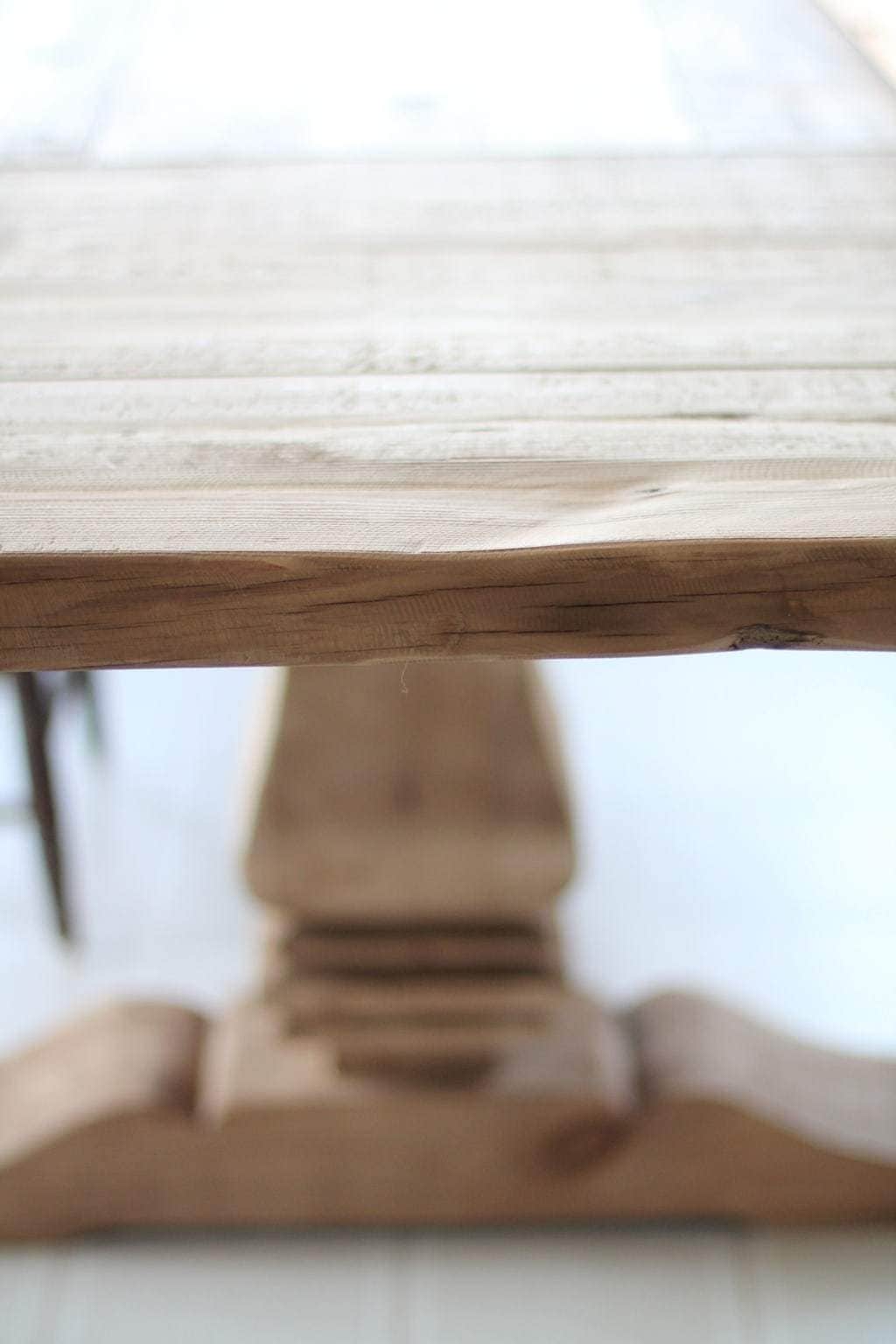
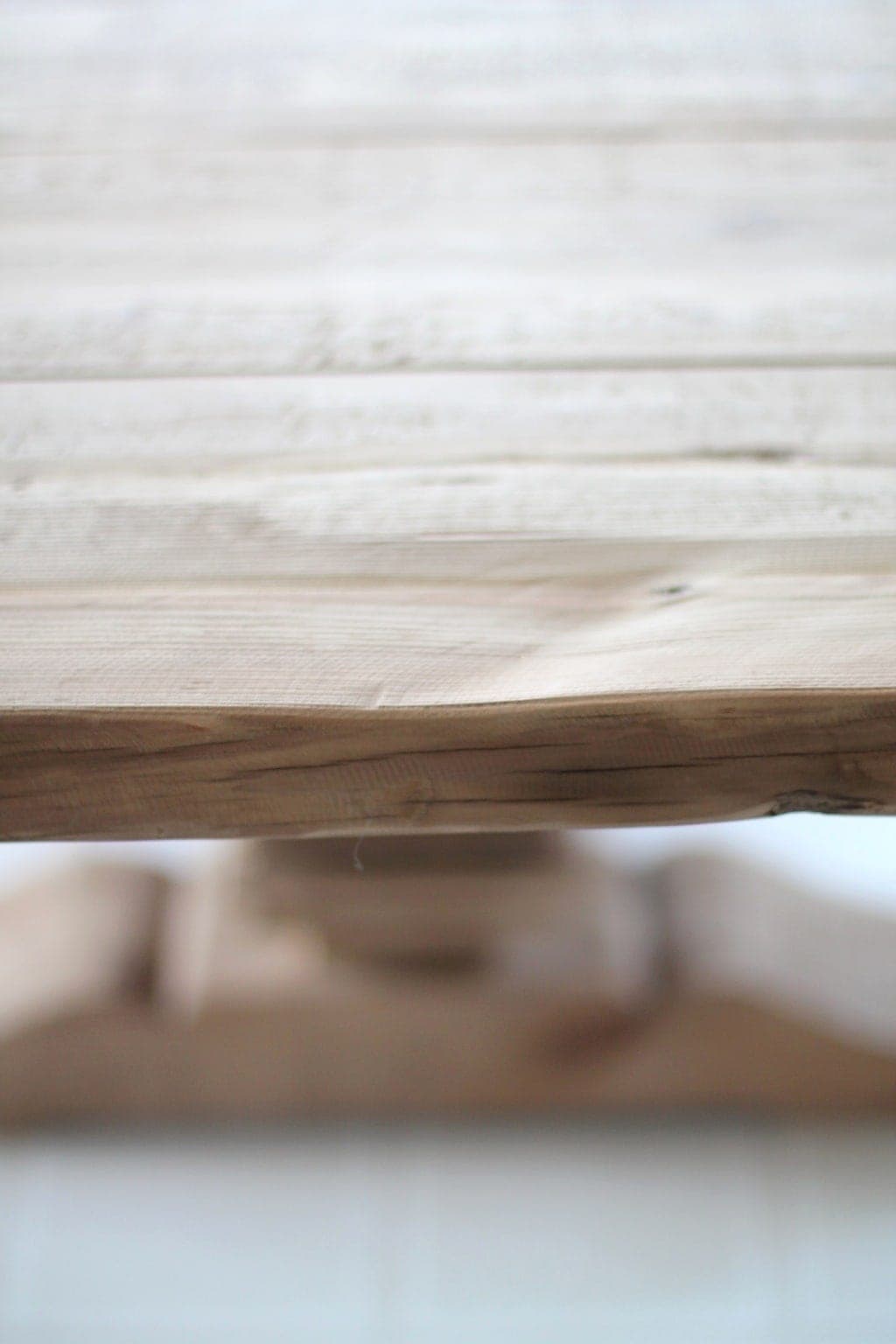
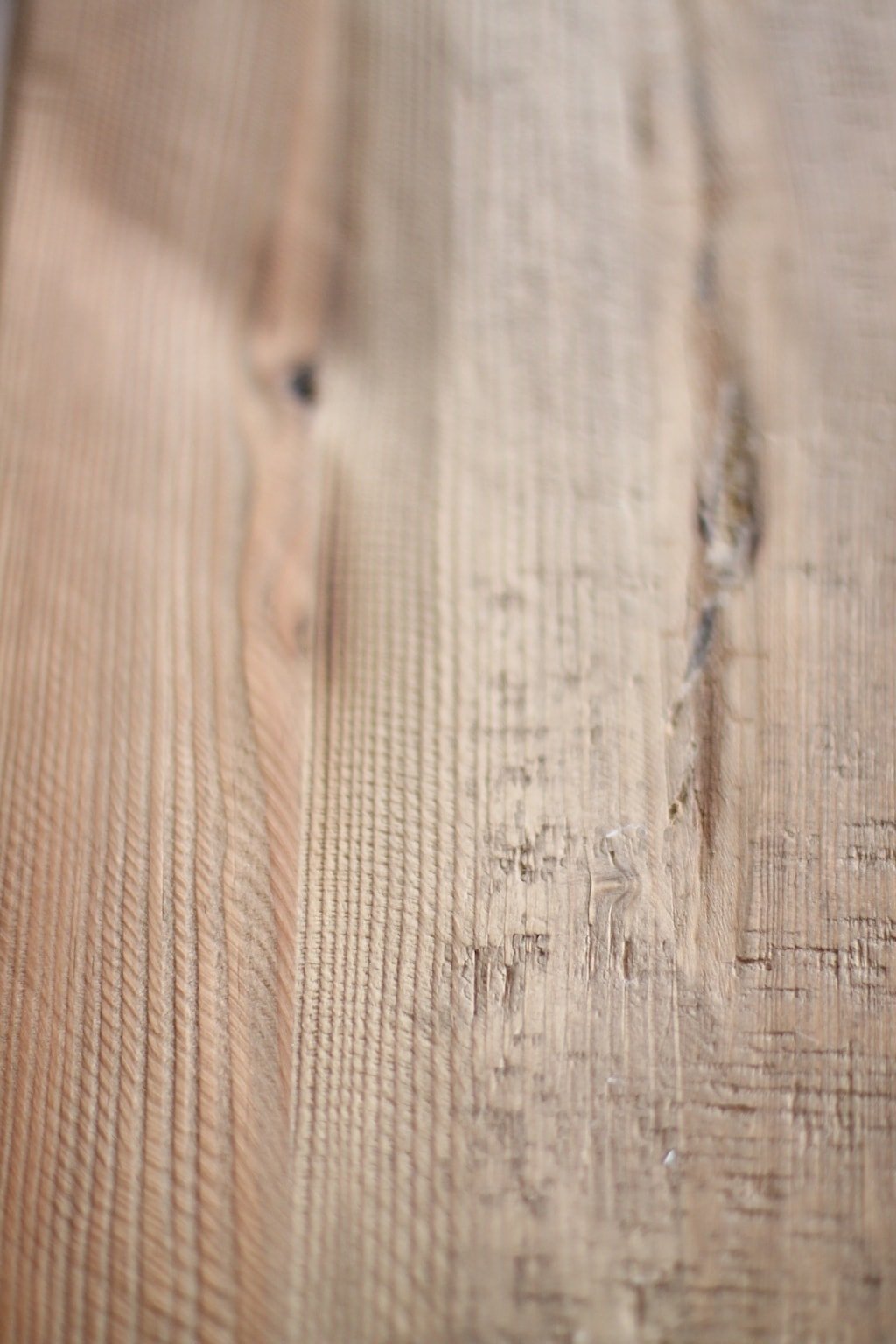
You can see the sheen from the tung oil in the picture below:

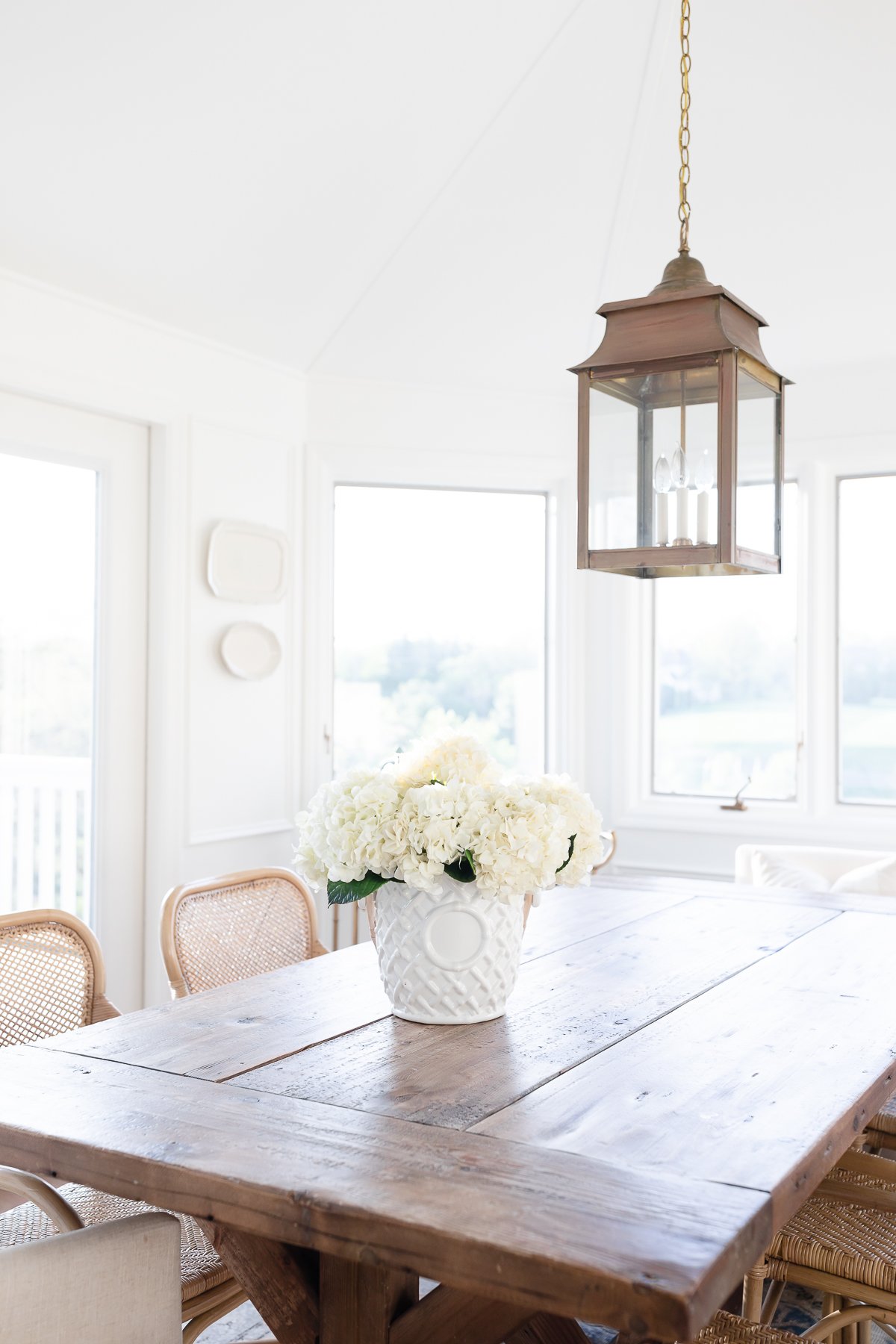
Tools and Supplies
- Pure Tung Oil
- Flour Sack Towels
- 0000 Super Fine Steel Wool
How to Use Tung Oil
- Apply Tung Oil with on with white flour sack towels.
- Have a second person follow behind to remove any excess.
- Use steel wool to dull the finish.
- Repeat.
The more muscle you put into using the steel wool the more natural your finish will be.
This method can be used with any farmhouse table or reclaimed wood table.
Update April 2019
Nearly five years later, I still receive a lot of questions about our Restoration Hardware dining table. The tung oil has held up incredibly well. To date, we have not reapplied and don’t see a need to do so.
The finish has continued to fade over time offering a softer, more natural aesthetic. All glue, marker and even candle wax have been removed effortlessly!
Update March 2024
Same story! We love our table and have never needed to change or alter the finish.

What Stain Color Best Matches Restoration Hardware’s Natural Finish?
If you have to stain your RH wood table because of a re-do, or are building your own farmhouse table to capture that look, Minwax Driftwood came the closest to the natural finish of the Restoration Hardware Dining Table.
It seeps into the pores of the wood, so the quicker you wipe it off to remove it, the less color that will be applied, however, it gets pretty dark in the grooves.
Here are some examples on various boards. I applied it and Chris followed behind wiping it off. These images are before the tung oil was applied.
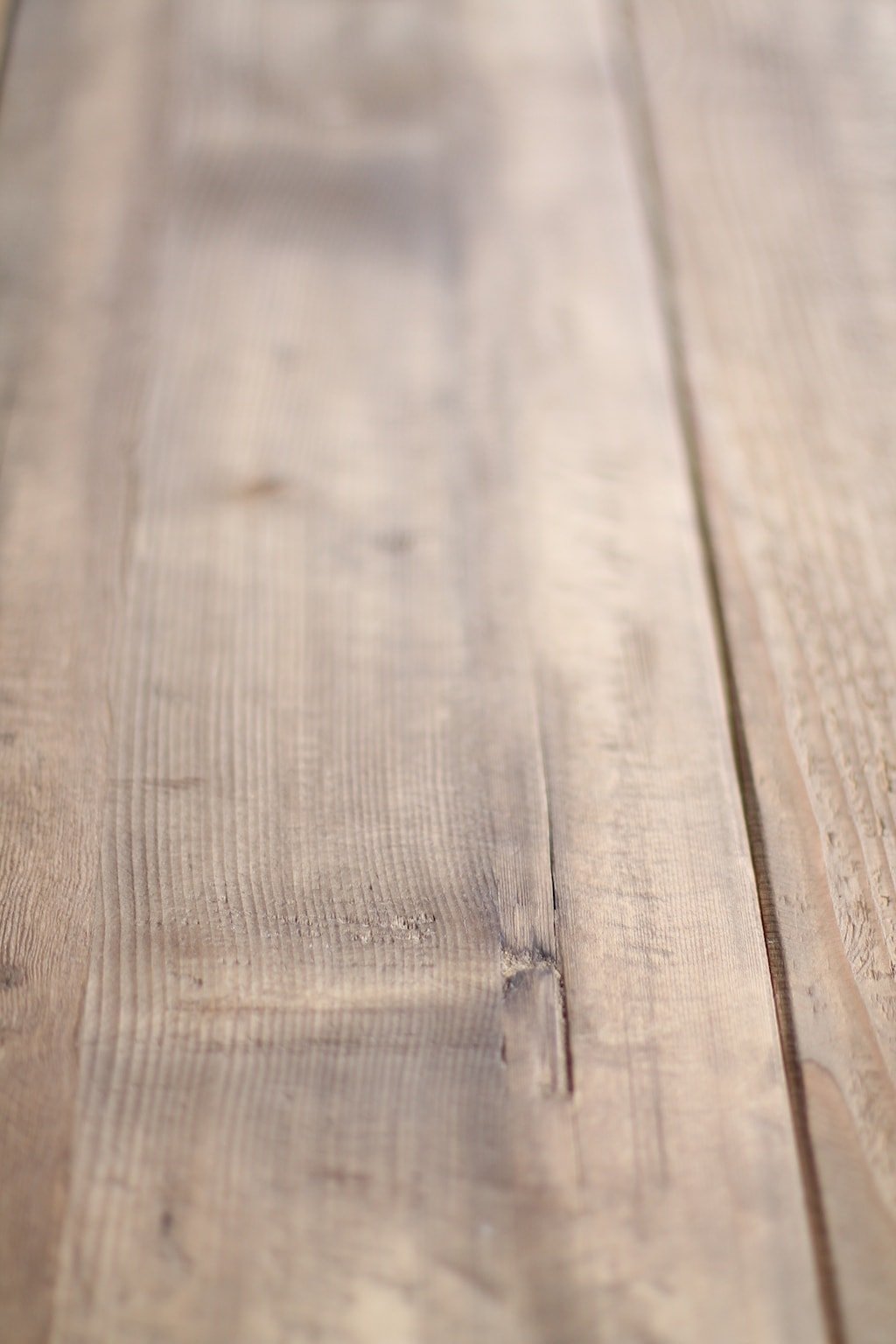

In Conclusion
What did we learn?
Redefine expectations.
In the end, it’s not perfect, but it’s functional and looks nice. If you have experienced a similar situation, know that you will make peace with it, eventually!
I have learned so much from this table. One of the most important lessons is that sometimes we need to redefine our expectations.
It’s just a table.
Through all of your comments and emails, I learned that I am not alone. More importantly, I remembered that it’s just a table. Despite wasted time, money and energy, it’s still just a table.
It’s the reclaimed wood table that brought us together to help each other. If you have an experience with your table and can offer additional help to others, please leave a comment below. If this post can save someone even a few of the hours and frustration we put into our table, it’s worth it.
I hope this post has helped you make a decision you’re comfortable with to protect your farmhouse table. Please use comments below (rather than emailing) so that your questions and comments help others, too!

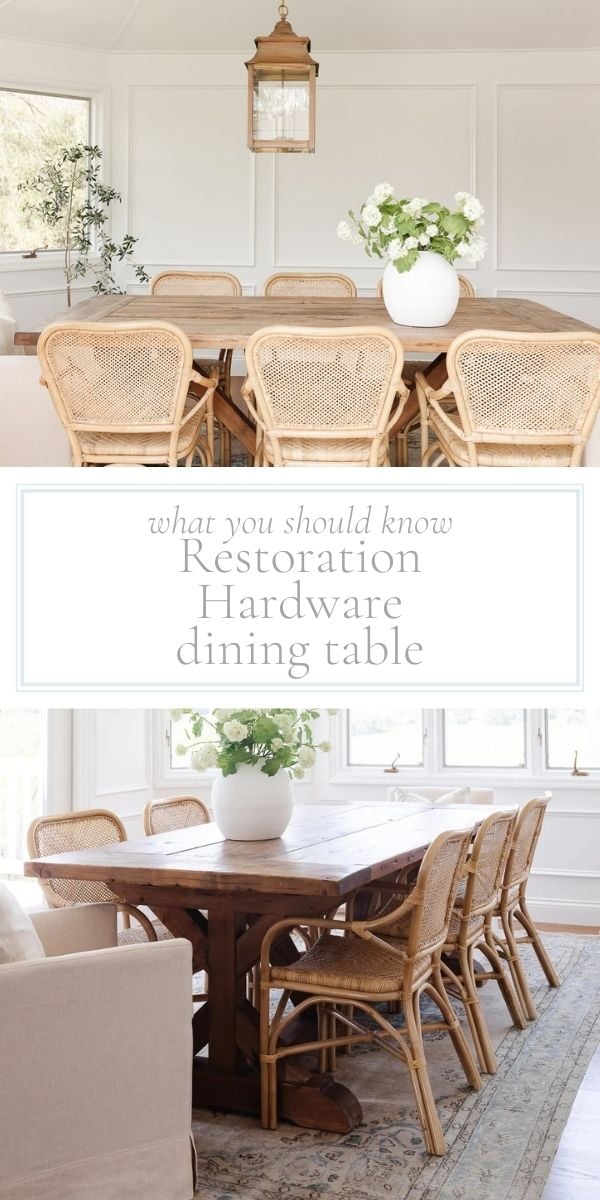
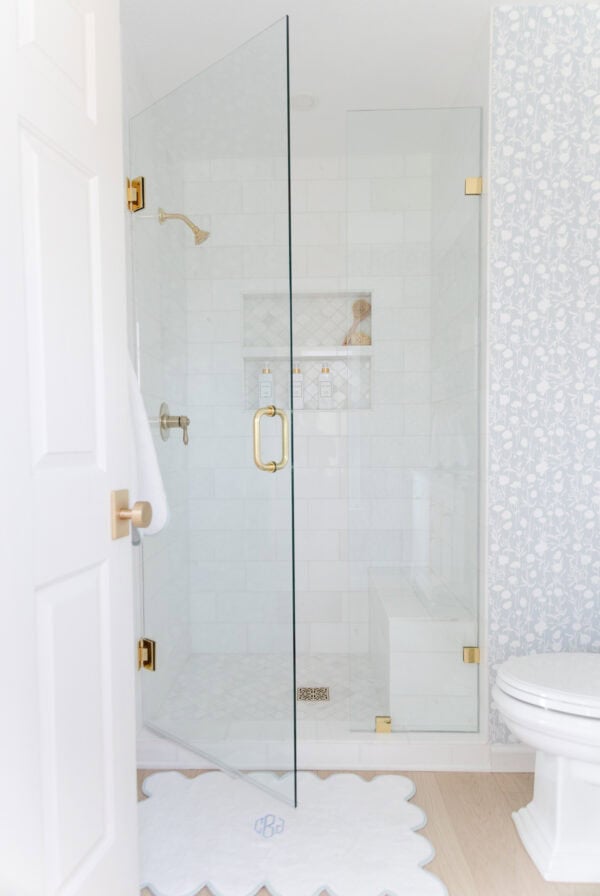
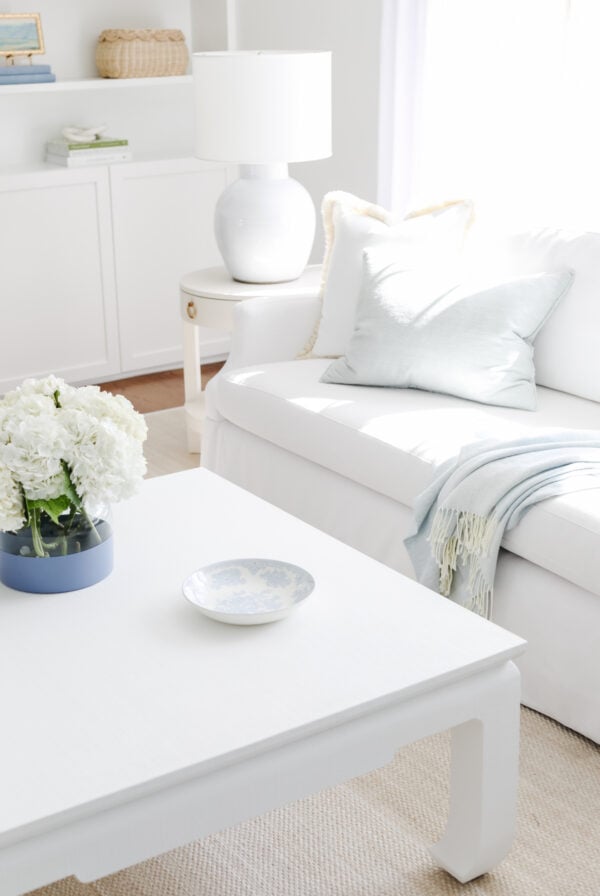
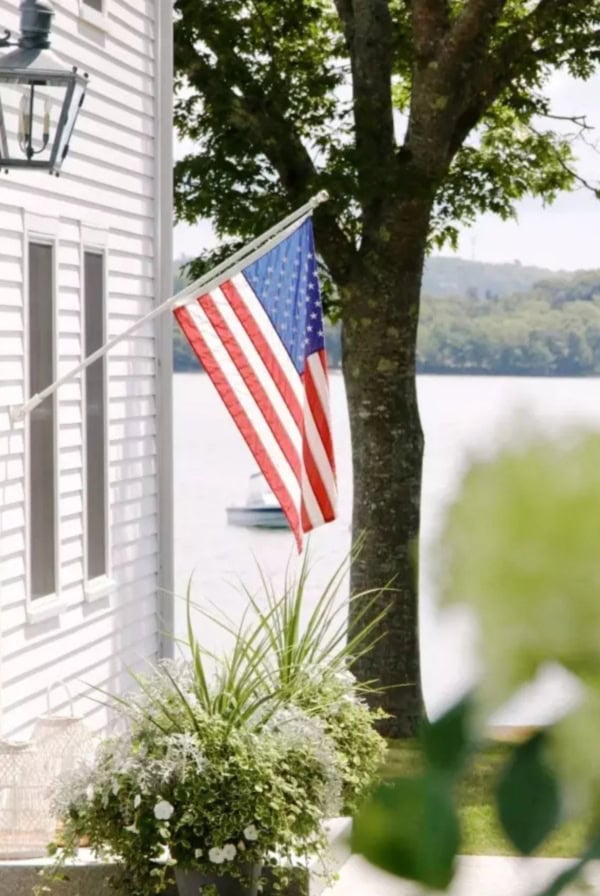






I just recieved my RH table Tuesday, but didn’t read the reviews until it was on it’s way, I’ve been panicking over what to do. We have 7 grandchildren (5 are little boys!) and I don’t want a table I have to fuss over. I called 3 RH stores and everyone gave me a different answer as what to do. One said embrace the stains, that’s the beauty of the table, not sure I agree. Thanks so much for your information, I have read so many opinions on this table and yours has been the most helpful. I am going to seal ours with tung oil, but you did say it doesn’t change the color, correct? Thank you for all the information, I feel a little calmer now 🙂 I’m hosting Easter for 30 so now I have to get busy and seal my table! Just found your blog and I love it!
Only ever so slightly-if you use true 100% tung oil. Many are a solution combined with additives. I love our table 10x over & even after the headache, would do it again! Earlier this week we forgot a sippy cup on the table to find it had overflowed overnight. We simply wiped the table down with absolutely no damage! The water didn’t penetrate the wood at all, let alone leave a ring. Enjoy the memories you’ll make at your new table, Linda! Happy Easter!
Hi Julie,
Bless you for this post! I recently purchased the 1900s Boulangerie table in salvaged natural and oh that darn powder finish! It’s so pretty but I know it won’t last if it’s not protected. Most people online have used Monocoat Oil but I purchased a sample and used it on the underside of the table and it turns it much much darker and brings out amber tones that I don’t care for. I am considering scrubbing the powder off to see if that will help with the darkness, but I know it won’t help with the amber. I am also considering sanding the powder finish completely off and then staining it and sealing it. It seems as thought that is the process you chose? The color of your table looks great, very similar to the salvaged natural and not amber at all. I just wanted to verify and see if you sanded, restained with the whole table with the miniwax driftwood and then applied the tung oil?
If I were you, I’d wipe the powder finish off & do tung oil. Unfortunately, we started with the monocoat & despised how dark it was & lightly sanded the main area of the table {not the leaves}. I would avoid sanding at all costs because the beautiful grain can be lost. I’m sorry you’re experiencing the same issue! Best wishes.
Oh wait, so if I have a brand new rh table in natural finish you recommend removing the powder finish before applying the tung oil? Do you do the steel wool while still wet? Or wait for it to dry first? How much time between layers?
My table is arriving today and I’m eager to get it protected (I have little ones) and into regular use.
Thanks so much
We didn’t remove it, we just added over it. It will change it, but it will not sustain without doing something.
Thanks so much for posting all this information on the RH table. I was about to purchase it but was hesitant because I have 3 young kids and was worried about the stains and maintenance. This post was incredibly helpful.
Thanks Michelle! If you protected as soon as it arrives you’ll be fine and never have to touch it again.
Hi there!
I’m madly in love with my BALUSTRADE SALVAGED WOOD SQUARE COFFEE TABLE from RH with the natural finish and am distraught about letting it go. Of course, we immediately spilled a few droplets of water and it left a stain that was much lighter than the natural finish. We then had to wipe the whole finish off to give it the same color. I was so glad to find your blog post and was hoping you could explain your directions a bit further.
You stated that “It’s not supposed to alter the color of the wood. However, the first coat must be used with a combination of paint thinner, which does. It released red tones in the wood we finished. A week later & I found it less noticeable.It has a matte finish. It can have a slightly more matte appearance with A LOT of steel wool & willpower.”
Do you think you could explain that further? I see that you mixed the paint thinner with the tung oil. How much of each did you use? Did you use a paint brush or did a cloth? What if I did not use the paint thinner? Also, how did you go about removing the tung oil? A steel wool from a hardware store?
We’re wondering whether we should just leave it as is or get it replaced with the same table and then put the tung oil on the finish already on the table.
I hope you can help and look forward to your reply!
I’m EXTREMELY happy with how the tung oil is holding up. I no longer notice red tones. I don’t know what would happen if you didn’t apply it with paint thinner, but we did, by brushing it on. We used cloths to wipe everything off & steel wool from the hardware store to remove the appearance. It’s now 95% matte & I could probably work harder to give it it’s original appearance if I had any energy left in me. Best wishes!
Hi Julie, I just bought the same table before reading your post. Thank you for posting your experience! I noticed a stain on the top before we sat down to eat our first dinner. I was annoyed. As we started to eat, a little spill happened and we wiped it, but you can imagine what happened next! Needless to say, RH is going to send a replacement. I am going to immediately protect the next one. Can you provide step by step instructions on how you used the Tung oil? Also, how much thinner vs oil did you use? I am not a do it yourself girl – so this makes me nervous and I don’t want to mess it up! thank you!!!
Not much thinner & the tung oil couldn’t be easier. Put it on & wipe it off immediately, ensuring you’re removing from cracks as well & allow to dry! It is really simple!
you make it sounds too easy! thanks and fingers crossed!
this is exactly the same situation we are in..going down all the comments as we speak, but so far finding all very helpful – thank you all for sharing your experiences! with all being said would you still recommend purchasing this table and/or finish or think better/less stress to go with another finish assuming any of the other RH finishes don’t have the same problem?
I’m still happy with it, personally. It’s not quite the dusty look that I initially loved, but everyone that comes over raves about how beautiful it is and it’s still more beautiful than anything else I’ve found.
Thank you for sharing your experience. I have been searching high and low for the perfect farmhouse/reclaimed style dining table for our home. My husband and I have opposing expectations and style choices, which leave me very limited. I was considering a RH Baluster dining table which I surprisingly found on sale today, however I am seriously reconsidering after reading about your experience.
Thank you!
When we visited the Outlet last weekend we noticed a coffee table with two glass rings on it that was returned for obvious reasons. I would do the table over again – IF I knew ahead of time that I would need to protect it & protected it before use.